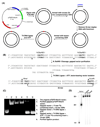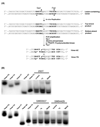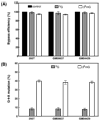6-Thioguanine and S⁶-methylthioguanine are mutagenic in human cells
- PMID: 20806951
- PMCID: PMC3010245
- DOI: 10.1021/cb100214b
6-Thioguanine and S⁶-methylthioguanine are mutagenic in human cells
Abstract
Thiopurines are effective immunosuppressants and anticancer agents. However, the long-term use of thiopurines was found to be associated with a significantly increased risk of various types of cancer. To date, the specific mechanism(s) underlying the carcinogenicity associated with thiopurine treatment remain(s) unclear. Herein, we constructed duplex pTGFP-Hha10 shuttle vectors carrying a 6-thioguanine ((S)G) or S⁶-methylthioguanine (S⁶mG) at a unique site and allowed the vectors to propagate in three different human cell lines. Analysis of the replication products revealed that although neither thionucleoside blocked considerably DNA replication in any of the human cell lines, both (S)G and S⁶mG were mutagenic, resulting in G→A mutation at frequencies of ~8% and ~39%, respectively. Consistent with what was found from our previous study in E. coli cells, our data demonstrated that the mutagenic properties of (S)G and S⁶mG provided significant evidence for mutation induction as a potential carcinogenic mechanism associated with chronic thiopurine intervention.
Figures




Similar articles
-
Mutagenic and cytotoxic properties of 6-thioguanine, S6-methylthioguanine, and guanine-S6-sulfonic acid.J Biol Chem. 2008 Aug 29;283(35):23665-70. doi: 10.1074/jbc.M804047200. Epub 2008 Jun 30. J Biol Chem. 2008. PMID: 18591241 Free PMC article.
-
Cytotoxic mechanism of 6-thioguanine: hMutSalpha, the human mismatch binding heterodimer, binds to DNA containing S6-methylthioguanine.Biochemistry. 1997 Mar 4;36(9):2501-6. doi: 10.1021/bi9621573. Biochemistry. 1997. PMID: 9054555
-
Effects of 6-thioguanine and S6-methylthioguanine on transcription in vitro and in human cells.J Biol Chem. 2012 Nov 30;287(49):40915-23. doi: 10.1074/jbc.M112.418681. Epub 2012 Oct 17. J Biol Chem. 2012. PMID: 23076150 Free PMC article.
-
International Commission for Protection Against Environmental Mutagens and Carcinogens. Mutagenicity and carcinogenicity of topoisomerase-interactive agents.Mutat Res. 1994 Aug 1;309(1):109-42. doi: 10.1016/0027-5107(94)90048-5. Mutat Res. 1994. PMID: 7519727 Review.
-
International Commission for Protection Against Environmental Mutagens and Carcinogens. The subtlety of alkylating agents in reactions with biological macromolecules.Mutat Res. 1994 Feb 1;305(1):13-32. doi: 10.1016/0027-5107(94)90123-6. Mutat Res. 1994. PMID: 7508544 Review.
Cited by
-
The roles of polymerases ν and θ in replicative bypass of O6- and N2-alkyl-2'-deoxyguanosine lesions in human cells.J Biol Chem. 2020 Apr 3;295(14):4556-4562. doi: 10.1074/jbc.RA120.012830. Epub 2020 Feb 25. J Biol Chem. 2020. PMID: 32098870 Free PMC article.
-
Cytotoxic and Mutagenic Properties of C1' and C3'-Epimeric Lesions of 2'-Deoxyribonucleosides in Human Cells.ACS Chem Biol. 2019 Mar 15;14(3):478-485. doi: 10.1021/acschembio.8b01126. Epub 2019 Feb 25. ACS Chem Biol. 2019. PMID: 30768892 Free PMC article.
-
Effects of tet-induced oxidation products of 5-methylcytosine on DNA replication in mammalian cells.Chem Res Toxicol. 2014 Jul 21;27(7):1304-9. doi: 10.1021/tx500169u. Epub 2014 Jul 10. Chem Res Toxicol. 2014. PMID: 24979327 Free PMC article.
-
Mass spectrometry for the assessment of the occurrence and biological consequences of DNA adducts.Chem Soc Rev. 2015 Nov 7;44(21):7829-54. doi: 10.1039/c5cs00316d. Chem Soc Rev. 2015. PMID: 26204249 Free PMC article. Review.
-
Thiopurine methyltransferase predicts the extent of cytotoxicty and DNA damage in astroglial cells after thioguanine exposure.PLoS One. 2011;6(12):e29163. doi: 10.1371/journal.pone.0029163. Epub 2011 Dec 21. PLoS One. 2011. PMID: 22216194 Free PMC article.
References
-
- Elion GB. The purine path to chemotherapy. Science. 1989;244:41–47. - PubMed
-
- Podolsky DK. Inflammatory bowel disease (1) N. Engl. J. Med. 1991;325:928–937. - PubMed
-
- Present DH, Korelitz BI, Wisch N, Glass JL, Sachar DB, Pasternack BS. Treatment of Crohn's disease with 6-mercaptopurine. A long-term, randomized, double-blind study. N. Engl. J. Med. 1980;302:981–987. - PubMed
-
- Pui CH, Evans WE. Acute lymphoblastic leukemia. N. Engl. J. Med. 1998;339:605–615. - PubMed
-
- Pui CH, Jeha S. New therapeutic strategies for the treatment of acute lymphoblastic leukaemia. Nat. Rev. Drug Discov. 2007;6:149–165. - PubMed
Publication types
MeSH terms
Substances
Grants and funding
LinkOut - more resources
Full Text Sources

